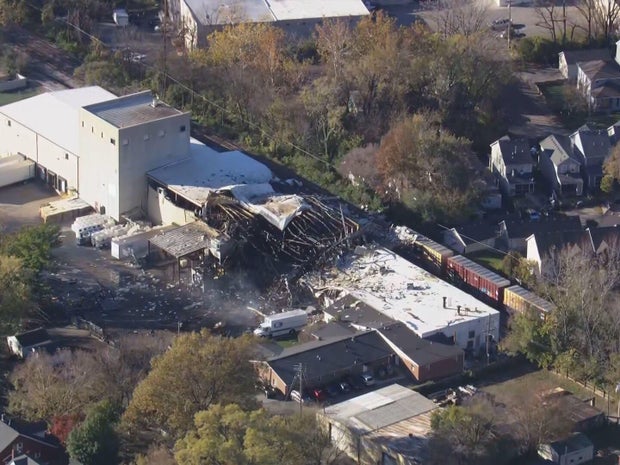CBS News
Small-town patients face big hurdles as rural hospitals cut cancer care

The night before her chemotherapy, Herlinda Sanchez sets out her clothes and checks that she has everything she needs: a blanket, medications, an iPad and chargers, a small Bible and rosary, fuzzy socks and snacks for the road.
After the 36-year-old was diagnosed with stage 3 breast cancer in December, she learned that there weren’t any cancer services in her community of Del Rio, a town of 35,000 near the Texas-Mexico border.
To get treatment, she and her husband, Manuel, must drive nearly three hours east to San Antonio. So they set an alarm for 4 a.m., which allows for just enough time to roll out of bed, brush their teeth and begin the long drive navigating dark roads while watching for deer.
Lisa Krantz for KFF Health News
About an hour before they arrive at the cancer clinic, the couple pulls over to quickly eat fast food in the car. The break gives Herlinda time to apply ointment on the port where the needle for her chemotherapy will be inserted.
“It numbs the area, so when I get to the infusion room the needle won’t hurt,” she said.
For rural patients, getting cancer treatment close to home has always been difficult. But in recent years, chemotherapy deserts have expanded across the United States, with 382 rural hospitals halting services from 2014 to 2022, according to a report published this spring by Chartis, a health analytics and consulting firm.
Texas led that list, with 57 rural hospitals — nearly half of those statewide that had offered chemotherapy — cutting the service by 2022, according to the analysis. Rural hospitals in states like Texas, which hasn’t expanded Medicaid, have been more likely to close, according to data from the Cecil G. Sheps Center for Health Services Research.
To keep the doors open, financially strapped facilities in small communities nationwide continue to shed basic health care services, like obstetrics and chemotherapy, said Michael Topchik, executive director of the Chartis Center for Rural Health.
“The data are staggering,” Topchik said. “Can you imagine feeling that sick, and having to drive an hour in each direction, or maybe more each direction, several times a week?”
Loss of chemotherapy services can signal other gaps in cancer care, such as a shortage of local specialty physicians and nurses, which is bad news for patients, said Marquita Lewis-Thames, an assistant professor at Northwestern University in Chicago whose research covers rural cancer care.
Rural patients are less likely to survive at least five years after a cancer diagnosis compared with their urban counterparts, concluded a study co-authored by Lewis-Thames and published in JAMA Network Open in 2022. While the rural-urban survival gap narrowed over the nearly 40 years researchers studied, the disparity persisted across most racial and ethnic groups, with only a few exceptions, she said.
Many cancer drugs are now given orally and can be taken at home, but some treatments for breast, colon and other common cancers must still be administered intravenously inside a medical facility. Even distances of an hour or two each way can strain patients who already may be coping with nausea, diarrhea, and other side effects, physicians and patient advocates said.
“It’s pretty uncomfortable for some of these patients who may have bone metastases or have significant muscular pain and have to sit in the car that long and hit road bumps,” said Shivum Agarwal, a family physician who practices in rural communities an hour west of Fort Worth, Texas.
Plus, travel can cost much more than filling the gas tank.
“Usually it requires an able-bodied family member taking off a whole day or at least half a day from work,” Agarwal said. “So, there’s a big economic cost for the family.”
In this sense, the Sanchez family is fortunate. Herlinda’s mother drives four hours from Abilene to Del Rio to watch the couple’s youngest children, their 2-year-old twins.
Lisa Krantz for KFF Health News
Cancer infusions can last as long as eight hours on top of the travel time, causing significant financial and logistical challenges, said Erin Ercoline, executive director of the San Antonio-based ThriveWell Cancer Foundation. The nonprofit provides adult patients with financial assistance, including for gaps in insurance and transportation-related costs. It has helped cover gasoline for Sanchez, who received her final round of chemotherapy in late June. The financial assistance will also pay for her hotel when she travels for breast surgery in August.
Not all rural hospitals are ending chemotherapy. Childress Regional Medical Center, a 39-bed hospital in West Texas, is constructing a 6,000-square-foot center for patients who need infusions for cancer and other diagnoses, including multiple sclerosis and rheumatology.
The infusion area, which started with two chairs in 2013 and now has four, will grow to 10 chairs and have more patient privacy when it opens next year. The next-nearest infusion center in this sprawling region is an hour or more away, which discourages some patients from seeking care, said Childress’ CEO, Holly Holcomb.
“We’ve had a handful of patients say, ‘If you can’t do it here, I’m not doing it,'” Holcomb said. She credits the federal 340B drug discount program for enabling the remote hospital to provide infusion drugs.
Hospitals that qualify for 340B can buy outpatient drugs at steep discounts. The program provides “a huge kickstand for rural hospitals,” said Topchik, of Chartis Center. Hospitals can use the savings to buoy or expand services provided to the community, he said.
But some patients are not daunted by long drives and travel costs.
Charlotte Huff for KFF Health News
“I’m from the country, so small is better — it’s just more personable,” said Dennis Woodward, 69, who lives in Woodson, Texas. He has a type of non-Hodgkin lymphoma and chooses to make a two-hour drive to Childress. He had first visited an oncology clinic in Abilene about an hour away. The clinicians were nice, but “I felt like a number,” he said.
After his first appointment at Childress this year, his oncologist, Fred Hardwicke, walked him over to meet the nurses who would administer the medicine, Woodward recalled.
Most Fridays during Herlinda Sanchez’s chemotherapy, Manuel would nap in the car. But during her final treatment in June, he stayed nearby, counting down the hours.
Several family members joined Herlinda when she rang the bell later that afternoon to signal the end of her treatment.
“I don’t want to be in San Antonio no more,” said Herlinda, a mother of four who does administrative work at Laughlin Air Force Base near Del Rio. “I’m looking forward to the break.”
KFF Health News is a national newsroom that produces in-depth journalism about health issues and is one of the core operating programs at KFF — the independent source for health policy research, polling and journalism.
CBS News
Explosion at Louisville plant leaves 11 employees injured

At least 11 employees were taken to hospitals and residents were urged to shelter in place on Tuesday after an explosion at a Louisville, Kentucky, business.
The Louisville Metro Emergency Services reported on social media a “hazardous materials incident” at 1901 Payne St., in Louisville. The address belongs to a facility operated by Givaudan Sense Colour, a manufacturer of food colorings for soft drinks and other products, according to officials and online records.
Louisville Mayor Craig Greenberg said emergency teams responded to the blast around 3 p.m. News outlets reported that neighbors heard what sounded like an explosion coming from the business. Overhead news video footage showed an industrial building with a large hole in its roof.
WLKY-TV
“The cause at this point of the explosion is unknown,” Greenberg said in a news conference. No one died in the explosion, he added.
Greenberg said officials spoke to employees inside the plant. “They have initially conveyed that everything was normal activity when the explosion occurred,” he said.
The Louisville Fire Department said in a post on the social platform X that multiple agencies were responding to a “large-scale incident.”
The Louisville Metro Emergency Services first urged people within a mile of the business to shelter in place, but that order was lifted in the afternoon. An evacuation order for the two surrounding blocks around the site of the explosion was still in place Tuesday afternoon.
CBS News
Briefing held on classified documents leaker Jack Teixeira’s sentencing

Watch CBS News
Be the first to know
Get browser notifications for breaking news, live events, and exclusive reporting.
CBS News
Aga Khan emerald, world’s most expensive green stone, fetches record $9 million at auction

A rare square 37-carat emerald owned by the Aga Khan fetched nearly $9 million at auction in Geneva on Tuesday, making it the world’s most expensive green stone.
Sold by Christie’s, the Cartier diamond and emerald brooch, which can also be worn as a pendant, dethrones a piece of jewelry made by the fashion house Bulgari, which Richard Burton gave as a wedding gift to fellow actor Elizabeth Taylor, as the most precious emerald.
In 1960, Prince Sadruddin Aga Khan commissioned Cartier to set the emerald in a brooch with 20 marquise-cut diamonds for British socialite Nina Dyer, to whom he was briefly married.
Dyer then auctioned off the emerald to raise money for animals in 1969.
FABRICE COFFRINI/AFP via Getty Images
By chance that was Christie’s very first such sale in Switzerland on the shores of Lake Geneva, with the emerald finding its way back to the 110th edition this year.
It was bought by jeweler Van Cleef & Arpels before passing a few years later into the hands of Harry Winston, nicknamed the “King of Diamonds.”
“Emeralds are hot right now, and this one ticks all the boxes,” said Christie’s EMEA Head of Jewellery Max Fawcett. “…We might see an emerald of this quality come up for sale once every five or six years.”
Also set with diamonds, the previous record-holder fetched $6.5 million at an auction of part of Hollywood legend Elizabeth Taylor’s renowned jewelry collection in New York.















